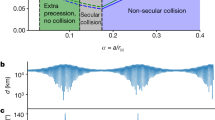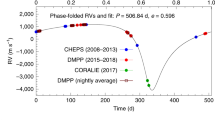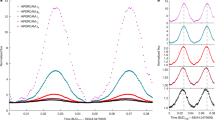Abstract
The cold classical Kuiper belt objects have low inclinations and eccentricities1,2 and are the only Kuiper belt population suspected to have formed in situ3. Compared with the dynamically excited populations, which exhibit a broad range of colours and a low binary fraction of ∼10%4 cold classical Kuiper belt objects typically have red optical colours5 with ∼30% of the population found in binary pairs6; the origin of these differences remains unclear7,8. We report the detection of a population of blue-coloured, tenuously bound binaries residing among the cold classical Kuiper belt objects. Here we show that widely separated binaries could have survived push-out into the cold classical region during the early phases of Neptune’s migration9. The blue binaries may be contaminants, originating at ∼38 au, and could provide a unique probe of the formative conditions in a region now nearly devoid of objects. The idea that the blue objects, which are predominantly binary, are the products of push-out requires that the planetesimals formed entirely as multiples. Plausible formation routes include planetesimal formation via pebble accretion10 and subsequent binary production through dynamic friction11 and binary formation during the collapse of a cloud of solids12.
This is a preview of subscription content, access via your institution
Access options
Access Nature and 54 other Nature Portfolio journals
Get Nature+, our best-value online-access subscription
$29.99 / 30 days
cancel any time
Subscribe to this journal
Receive 12 digital issues and online access to articles
$119.00 per year
only $9.92 per issue
Buy this article
- Purchase on Springer Link
- Instant access to full article PDF
Prices may be subject to local taxes which are calculated during checkout



Similar content being viewed by others
References
Brown, M. E. The inclination distribution of the Kuiper belt. Astron. J. 121, 2804–2814 (2001).
Kavelaars, J. J. et al. The Canada–France Ecliptic Plane Survey-L3 data release: the orbital structure of the Kuiper belt. Astron. J. 137, 4917–4935 (2009).
Parker, A. H. & Kavelaars, J. J. Destruction of binary minor planets during Neptune scattering. Astrophys. J. 722, L204–L208 (2010).
Noll, K. S., Grundy, W. M., Chiang, E. I., Margot, J.-L. & Kern, S. D. in The Solar System Beyond Neptune (eds Barucci, M. A., Boehnhardt, H., Cruikshank, D. P., Morbidelli, A. & Dotson, R.) 345–363 (Arizona Univ. Press 2008).
Gulbis, A., Elliot, J. & Kane, J. The color of the Kuiper belt core. Icarus 183, 168–178 (2006).
Grundy, W. et al. Five new and three improved mutual orbits of transneptunian binaries. Icarus 213, 678–692 (2011).
Benecchi, S. et al. The correlated colors of transneptunian binaries. Icarus 200, 292–303 (2009).
Fraser, W. C. & Brown, M. E. The Hubble Wide Field Camera 3 Test of Surfaces in the Outer Solar System: the compositional classes of the Kuiper belt. Astrophys. J. 749, 33 (2012).
Nesvorný, D. Jumping Neptune can explain the Kuiper belt kernel. Astron. J. 150, 68 (2015).
Shannon, A., Wu, Y. & Lithwick, Y. Forming the cold classical Kuiper belt in a light disk. Astrophys. J. 818, 175 (2016).
Goldreich, P., Lithwick, Y. & Sari, R. Formation of Kuiper-belt binaries by dynamical friction and three-body encounters. Nature 420, 643–646 (2002).
Nesvorný, D., Youdin, A. N. & Richardson, D. C. Formation of Kuiper belt binaries by gravitational collapse. Astron. J. 140, 785–793 (2010).
Bannister, M. T. et al. The Outer Solar System Origins Survey. I. Design and first-quarter discoveries. Astron. J. 152, 70 (2016).
Peixinho, N., Delsanti, A., Guilbert-Lepoutre, A., Gafeira, R. & Lacerda, P. The bimodal colors of Centaurs and small Kuiper belt objects. Astron. Astrophy. 546, A86 (2012).
Benecchi, S., Noll, K., Grundy, W. & Levison, H. (47171) 1999 TC36, a transneptunian triple. Icarus 207, 978–991 (2010).
Brown, M. E., Barkume, K. M., Ragozzine, D. & Schaller, E. L. A collisional family of icy objects in the Kuiper belt. Nature 446, 294–296 (2007).
Durda, D. D. et al. The formation of asteroid satellites in large impacts: results from numerical simulations. Icarus 167, 382–396 (2004).
Petit, J.-M. et al. The Canada–France Ecliptic Plane Survey full data release: the orbital structure of the Kuiper belt. Astron. J. 142, 131 (2011).
Petit, J.-M. et al. The extreme Kuiper belt binary 2001 QW322. Science 322, 432–434 (2008).
Brown, M. E., Schaller, E. L. & Fraser, W. C. A hypothesis for the color diversity of the Kuiper belt. Astrophys. J. 739, L60 (2011).
Johansen, A. et al. Rapid planetesimal formation in turbulent circumstellar disks. Nature 448, 1022–1025 (2007).
Schlichting, H. E. & Sari, R. The ratio of retrograde to prograde orbits: a test for Kuiper belt binary formation theories. Astrophys. J. 686, 741–747 (2008).
Fraser, W. C., Brown, M. E., Morbidelli, A., Parker, A. & Batygin, K. The absolute magnitude distribution of Kuiper belt objects. Astrophys. J. 782, 100 (2014).
Elliot, J. L. et al. The Deep Ecliptic Survey: a search for Kuiper belt objects and Centaurs. II. Dynamical classification the Kuiper belt plane, and the core population. Astron. J. 129, 1117–1162 (2005).
Batygin, K., Brown, M. E. & Fraser, W. C. Retention of a primordial cold classical Kuiper belt in an instability-driven model of Solar System formation. Astrophys. J. 738, 13 (2011).
Gladman, B., Marsden, B. G. & Vanlaerhoven, C. in The Solar System Beyond Neptune (eds Barucci, M. A., Boehnhardt, H., Cruikshank, D. P., Morbidelli, A. and Dotson, R.) 43–57 (Arizona Univ. Press 2008).
Benecchi, S., Noll, K., Stephens, D., Grundy, W. & Rawlins, J. Optical and infrared colors of transneptunian objects observed with HST. Icarus 213, 693–709 (2011).
Fraser, W. C., Brown, M. E. & Glass, F. The Hubble Wide Field Camera 3 Test of Surfaces in the Outer Solar System: spectral variation on Kuiper belt objects. Astrophys. J. 804, 31 (2015).
Peixinho, N., Delsanti, A. & Doressoundiram, A. Reanalyzing the visible colors of Centaurs and KBOs: what is there and what we might be missing. Astron. Astrophy. 577, A35 (2015).
Allington-Smith, J. et al. Integral field spectroscopy with the Gemini Multiobject Spectrograph. I. Design, construction, and testing. Publ. Astron. Soc. Pacif. 114, 892–912 (2002).
Hook, I. M. et al. The Gemini-North Multi-Object Spectrograph: performance in imaging, long-slit, and multi-object spectroscopic modes. Publ. Astron. Soc. Pacif. 116, 425–440 (2004).
Alam, S. et al. The eleventh and twelfth data releases of the Sloan Digital Sky Survey: final data from SDSS-III. Astrophys. J. Suppl. 219, 12 (2015).
Fraser, W. et al. TRIPPy: trailed image photometry in Python. Astron. J. 151, 158 (2016).
Boulade, O. et al. MegaCam: the new Canada–France–Hawaii telescope wide-field imaging camera. Proc. SPIE 4841, 72–81 (2003).
Dressler, A., Hare, T., Bigelow, B. C. & Osip, D. J. IMACS: the wide-field imaging spectrograph on Magellan-Baade. Proc. SPIE 6269, 62690F (2006).
Parker, A. H. & Kavelaars, J. J. Collisional evolution of ultra-wide trans-Neptunian binaries. Astrophys. J. 744, 139 (2011).
Levison, H. F. & Morbidelli, A. The formation of the Kuiper belt by the outward transport of bodies during Neptune’s migration. Nature 426, 419–421 (2003).
Nesvorný, D. & Morbidelli, A. Statistical study of the early Solar System’s instability with four five and six giant planets. Astron. J. 144, 117 (2012).
Wolff, S., Dawson, R. I. & Murray-Clay, R. A. Neptune on tiptoes: dynamical histories that preserve the cold classical Kuiper belt. Astrophys. J. 746, 171 (2012).
Nesvorný, D. & Vokrouhlický, D. Neptune’s orbital migration was grainy not smooth. Astrophys. J. 825, 94 (2016).
Brunini, A. & Zanardi, M. Dynamical and collisional evolution of Kuiper belt binaries. Mon. Not. R. Astron. Soc. 455, 4487–4497 (2015).
Astakhov, S. A., Lee, E. A. & Farrelly, D. Formation of Kuiper-belt binaries through multiple chaotic scattering encounters with low-mass intruders. Mon. Not. R. Astron. Soc. 360, 401–415 (2005).
Weidenschilling, S. On the origin of binary transneptunian objects. Icarus 160, 212–215 (2002).
Schlichting, H. E. & Sari, R. Formation of Kuiper belt binaries. Astrophys. J. 673, 1218–1224 (2008).
Leinhardt, Z. M. & Stewart, S. T. Collisions between gravity-dominated bodies. I. Outcome regimes and scaling laws. Astrophys. J. 745, 79 (2012).
Acknowledgements
This is work is based in part on observations from the Large and Long Program GN-2014B-LP-1, obtained at the Gemini Observatory, which is operated by the Association of Universities for Research in Astronomy, Inc., under a cooperative agreement with the National Science Foundation on behalf of the Gemini partnership: the National Science Foundation (USA), the National Research Council (Canada), CONICYT (Chile), Ministério de Ciência, Tecnología e Innovación Productiva (Argentina) and Ministério da Ciência, Tecnología e Inovação (Brazil). This work is also based on observations obtained with MegaPrime/MegaCam, a joint project of the Canada–France–Hawaii Telescope (CFHT) and CEA/DAPNIA at CFHT, which is operated by the National Research Council of Canada, the Institute National des Sciences de l’Universe of the Centre National de la Recherche Scientifique of France and the University of Hawaii. A portion of the access to the CFHT was made possible by the Institute of Astronomy and Astrophysics, Academia Sinica, Taiwan. This research used the facilities of the Canadian Astronomy Data Centre operated by the National Research Council of Canada with the support of the Canadian Space Agency. This paper includes data gathered with the 6.5 m Magellan Telescopes located at Las Campanas Observatory, Chile. The authors recognize and acknowledge the very significant cultural role and reverence that the summit of Mauna Kea has always had within the indigenous Hawaiian community. We are most fortunate to have the opportunity to conduct observations from this mountain. M.E.S. was supported by Gemini Observatory, which is operated by the Association of Universities for Research in Astronomy, Inc., on behalf of the international Gemini partnership of Argentina, Brazil, Canada, Chile and the United States. M.E.S. was also supported in part by an Academia Sinica Postdoctoral Fellowship. This research made use of the Giorgini, JD and Jet Propulsion Laboratory (JPL) Solar System Dynamics Group, NASA/JPL Horizons On-Line Ephemeris System (http://ssd.jpl.nasa.gov/?horizons). We thank J. Coffey for assistance in acquiring images of 2006 BR284.
Author information
Authors and Affiliations
Contributions
T.B., S.S. and C.T. acquired telescope observations enabling the binarity of 2002 VD131 to be detected. B.G., J.K., J.-M.P. and S.G., designed and with help from M.T.B., S.-Y.W, M.A. and Y.-T.C. operated the OSSOS survey, the detections of which were crucial to the success of the Col-OSSOS survey. K.V. provided dynamical analysis of all newly reported objects in this paper. K.N. provided confirmation of the statistical methods used in this paper. A.D., S.B. and M.J.L. helped to create the initial design and science plan for the Col-OSSOS survey. D.N. provided numerical simulations required to understand the formation of binary planetesimals. M.T.B., R.E.P., M.M., M.E.S. and J.K. were instrumental in the design and operations of the Col-OSSOS survey, from which the majority of colour measurements reported here were acquired. P.L. wrote some sections of the methods and provided insight into understanding our observations within the cloud collapse model. W.C.F. is the Principal Investigator of the Col-OSSOS survey and, with the help of R.E.P. and M.B., produced all photometry reported in this paper. W.C.F. produced the numerical migration and ejecta transfer simulations reported here and wrote the majority of the paper.
Corresponding author
Ethics declarations
Competing interests
The authors declare no competing interests.
Supplementary information
Supplementary Information
Supplementary Tables 1–3 and Supplementary Figures 1–4. (PDF 1139 kb)
Rights and permissions
About this article
Cite this article
Fraser, W., Bannister, M., Pike, R. et al. All planetesimals born near the Kuiper belt formed as binaries. Nat Astron 1, 0088 (2017). https://doi.org/10.1038/s41550-017-0088
Received:
Accepted:
Published:
DOI: https://doi.org/10.1038/s41550-017-0088
This article is cited by
-
Trans-Neptunian binaries as evidence for planetesimal formation by the streaming instability
Nature Astronomy (2019)
-
When did the planets migrate?
Nature Astronomy (2018)



